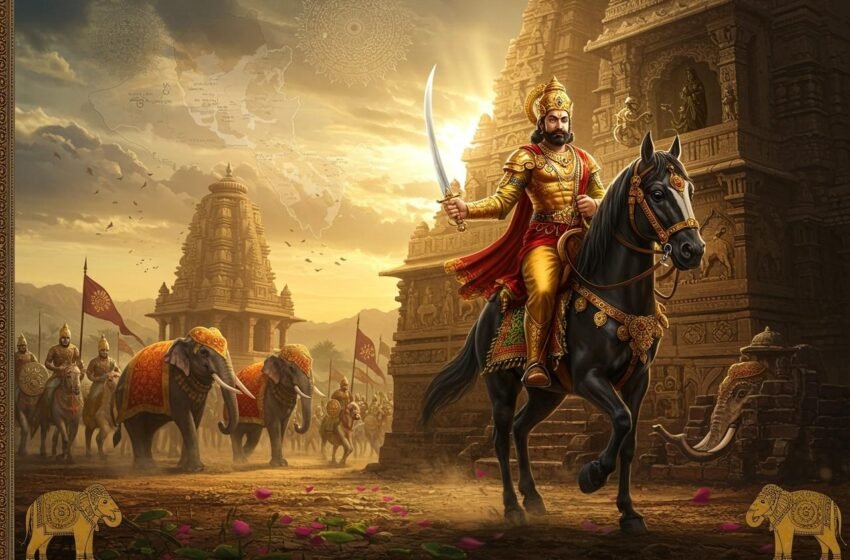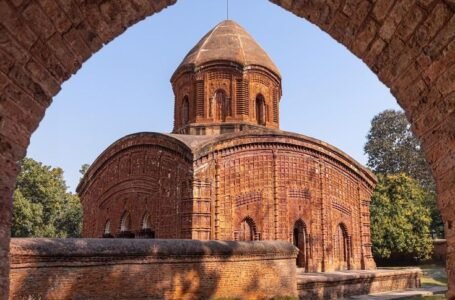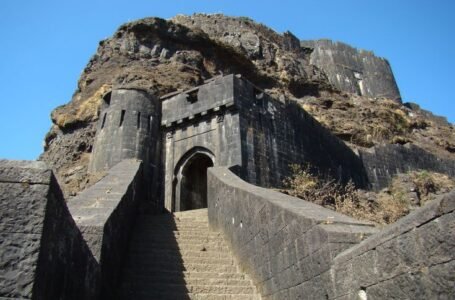The Lost Kings of India – Part II: Danti Durga – The Warrior Who Established the Rashtrakuta Empire

-Arushi Kastwar
In the ruined wake of dynasties, when mighty cities collapse and empires are in shambles, a new power will often emerge—forged not only by ambition, but by vision and resilience. Such a character out of India’s early medieval history is Danti Durga, the founder of the Rashtrakuta dynasty, who emerged out of the shade of the Chalukyas to forge a mighty kingdom that would overlord the Deccan and defy imperial powers both to the north and south.
While Pulakeshin II stood tall as a defender of the Deccan, Danti Durga rose from its ruins and constructed an empire that would bring southern India a golden era. This is the tale of a man who, while largely forgotten in histories, founded one of India’s greatest medieval dynasties.
The Post-Chalukyan Landscape: An Era in Chaos
When Pulakeshin II died defending Vatapi (Badami) from the Pallavas circa 642 CE, the Chalukya empire started breaking up. Although his successors took back control in due course, the political framework had been destabilized. Provincial governors and vassals started asserting independence, and among them were the Rashtrakutas, strong feudatories who initially operated under the Chalukyas.
By the early 8th century, the Chalukyas had further weakened. Opportunity came knocking—and Danti Durga answered.
Born into the Rashtrakuta dynasty, Danti Durga (also spelled Dantidurga or Dantivarman) was a member of a clan with a martial origin. They were said to rule portions of Berar (present-day Maharashtra) and were connected with regions such as Ellora and Nasik. Little is known about the early life of Danti Durga, but by the mid-8th century, he was the de facto ruler of the Rashtrakutas.
Danti Durga started out as a lieutenant to the Chalukya king Kirtivarman II, but he was more than a regional chief. With military prowess, political maneuvering, and religious authority, Danti Durga started gathering power.
One of his early military campaigns was the defeat of the Gurjaras, who ruled much of Gujarat and Malwa. He next campaigned to take Ujjain, a city of immense cultural and strategic value. These conquests brought him credibility throughout central India.
But his masterstroke was when he attacked his Chalukya masters.
In a sudden shift of power, Danti Durga overcame Kirtivarman II, reducing the Chalukya dynasty to its knees around 753 CE. This was the de facto start of the Rashtrakuta Empire, with Danti Durga as its inaugural sovereign ruler.
The Ellora Inscriptions and Historical Evidence
Our primary source on Danti Durga’s accomplishments is the Samangad copper plate inscription and the Ellora cave inscriptions, specifically in Cave 15 (the Dashavatara Cave).
These inscriptions speak of his military victories, the reach of his dominion, and his commitment to Shaivism. They refer to him as the one who conquered Kanchipuram, Malwa, Kosala, Kalinga, Lata, and the Gangas—a span that indicates he ruled a significant portion of peninsular India.
The inscriptions are assertive and imperial in their language, addressing Danti Durga as the “King of Kings” and the “champion of the Brahmanical order.”
Religion and Political Legitimacy
As with many early medieval Indian rulers, Danti Durga realized the value of religious patronage as a means of legitimizing his reign.
He was a Shiva devotee, and his inscriptions abound with descriptions of his piety.
He supported Brahmins and reinstated Vedic rites, such as the Hiranyagarbha ritual, whereby he symbolically reborn himself as a Kshatriya king—a necessary gesture because the Rashtrakutas were not considered to be Kshatriyas according to traditional varna norms.
He also promoted temple building and supported religious centers, especially around Ellora, which later became one of India’s most beautiful rock-cut temple complexes.
This combination of military power and religious alignment provided his reign with both power and legitimacy.
Danti Durga’s Empire: Extent and Structure
At the end of his rule, Danti Durga’s Rashtrakuta empire extended over a large part of the Deccan plateau. Though precise frontiers are disputed, historians think his empire comprised:
Maharashtra, northern Karnataka, and some of Madhya Pradesh
Territories conquered by campaign, such as Malwa, Lata (southern Gujarat), and some of Odisha and Andhra
Conquered or allied local powers such as the Ganga dynasty, who controlled some of present-day Karnataka.
In order to keep such a large territory, he probably kept the Chalukyan administrative apparatus intact, employing a mix of vassal chiefs, governors, and provincial rulers, all bound together by loyalty and tribute.
Danti Durga’s Diplomacy and Soft Power
While conquest brought him territory, Danti Durga was also an accomplished diplomat. He made strategic marriages, married into influential families, and employed religion as a unifying force.
He also kept friendly relations with other houses such as the Pallavas, perhaps in order to steer clear of any conflict on his southern border. This enabled him to concentrate on consolidating and governing his recently acquired empire.
During his reign, the Deccan transformed from a disunited territory into a unified empire, taking on an increasingly distinct identity which was neither purely northern nor purely southern, but distinctively Deccan.
A Short Reign, A Long Legacy
Danti Durga’s rule was quite brief—he passed away circa 756 CE, a mere few years after declaring himself emperor. Yet during that brief period, he:
Dethroned the powerful Chalukyas
Established a new imperial dynasty
Launched the Rashtrakutas onto one of India’s greatest dynasties
Upon his death, he was followed by his uncle Krishna I, who carried on the dynasty’s expansion. Krishna I would subsequently construct the Kailasa Temple at Ellora, one of the most magnificent rock-cut temples in the globe—a venture quite possibly envisioned within Danti Durga’s own reign.
The Rashtrakutas: A Legacy Born of Danti Durga’s Dream
Danti Durga established a dynasty that ruled for more than two centuries and produced such legendary kings as
Dhruva Dharavarsha – who took Rashtrakuta influence to the Ganga and Yamuna
Govinda III – who plundered Kanauj and vanquished the Pratiharas and Palas
Amoghavarsha I – a literary stalwart and one of India’s most renowned kings, famous for his patronage of literature and Jainism
Under these successors, the Rashtrakutas competed with the Pratiharas of the north and the Pallavas of the south to become India’s preeminent imperial power for an extended time.
All this would not have been possible if not for the foresight and courage of the first Rashtrakuta emperor, Danti Durga.
Conclusion: Danti Durga and the Fire That Renewed the Deccan
During a period when the Deccan was broken and fragmented, Danti Durga brought back peace through the sword and tactics, positioning the Rashtrakutas at the center of Indian history.
But history has not been generous to his memory. While his descendants and their monuments remain, Danti Durga’s name tends to disappear into the footnotes. But do not be mistaken: he was the architect of a new age, a king who emerged from vassalage to empire, from obscurity to greatness.
In this Lost Kings of India series, Danti Durga embodies the spirit of rebirth—the phoenix who emerged from Chalukyan embers to ignite a legacy that would dominate southern India for centuries.
Watch this space for Part III: Lalitaditya Muktapida, the shining king of Kashmir who aspired to empire from the Himalayas to the Ganges.


